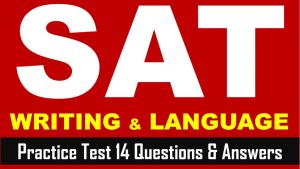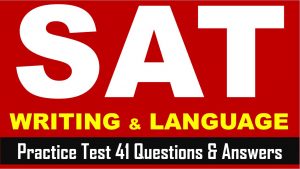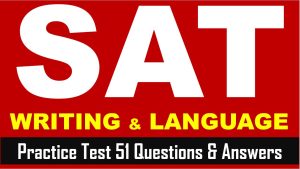Hi SAT Aspirants, welcome to AKVTutorials. As you know SAT (Scholastic Assessment Test) is a standard test, used for taking admission to undergraduate programs of universities or colleges of United States. SAT is developed and published by the College Board, an organization in United States, administered by the Educational Testing Service. Therefore, you need to do practice on SAT Reading Section, SAT Writing and Language Section. In this article, you will get SAT Reading Writing Practice Test 38 with Answer Keys AMBIPi
Instruction:
- In the passage below is accompanied by a number of questions.
- For some questions, you need to think how the passage might be revised to improve the expression of ideas.
- For other questions, you will consider how the passage might be edited to correct errors in sentence structure, usage, or punctuation.
- Some questions will direct you to an underlined portion of a passage.
- Other questions will direct you to a location in a passage or ask you to think about the passage as a whole.
SAT Writing & Language Section Passage
SAT Writing Passage Title: The Bloody Jungle of the Belgian Congo
In 1890, a young writer named Joseph Conrad took a job on a steamship in the Belgian 1 Congo; a European colony in central Africa. In Europe, he had heard of all the wonderful work that was happening there. King Leopold II of Belgium had won the admiration of many in Europe and America for his descriptions of his colony. 2
But what Conrad 3 found- immortalized in his short novel Heart of Darkness, could in no way be reconciled with the grandiose descriptions of progress 4 towards civilization in what Europeans perceived as an uncivilized part of the world. The novel describes a devastated landscape and an overworked and underfed African labor force that had essentially been conquered and enslaved. Violent atrocities had become the 5 norm, being all, for the sake of ivory and rubber. They were the result of greed and ruthlessness on a massive scale, enabled by European attitudes of racial superiority and abetted by zealous men and women 6 whose belief that colonization would bring a higher quality of life to Africans.
By the time Heart of Darkness was published in 1902, a movement was already underway to expose the the large-scale theft and murder occurring in the Congo 7 Dozens of missionaries had begun sending reports, including photographs, to bear witness to the violence. William Sheppard, an African-American Presbyterian, was one of these missionaries. He sent out shocking testimony of lands being seized by force, of people living under a reign of terror, and 8 soldiers who cut. off the hands of women and children.
An Englishman named E.D Morel gathered the many reports and photographs and 9 published them. He drew crowds to listen to eyewitness accounts of colonial atrocities. He lobbied the British Parliament to denounce the Belgian king’s 10 horrifying, even terrifying, practices. This became the first modern humanitarian movement, 11 and they successfully exposed the horrendous violence in the Congo. However, historians estimate that, by that time, between 10 million and 20 million Congolese people had lost their lives.
SAT Writing & Language Practice Questions
Question No 1
Which choice best maintains the sentence pattern already established in the paragraph?
Option A : No Change
Option B : Congo
Option C : Congo,
Option D : Congo, and
Answer
Show/Hide Answer
Option C : Congo,
because The phrase a European colony… is a nonessential phrase that should be set off by a comma.
Question No 2
Which choice most logically follows the previous sentence?
Option A : Due to his popularity, he had the longest reign of any Belgian monarch.
Option B : In 1893, he oversaw the first revision of the Belgian constitution, which introduced universal male suffrage.
Option C : He maintained Belgium’s neutrality in times of war by building a strong military defense.
Option D : He had spoken eloquently of philanthropy, free trade, scientific exploration, and the end of the Arab slave trade in central Africa.
Answer
Show/Hide Answer
Option D : He had spoken eloquently of philanthropy, free trade, scientific exploration, and the end of the Arab slave trade in central Africa.
because Given the previous sentence, the one in question should elaborate on his descriptions of his colony. Answer D is the one that does that.
Question No 3
Which choice provides the most effectively transition to the information that follows?
Option A : No Change
Option B : found
Option C : found;
Option D : found:
Answer
Show/Hide Answer
Option B : found
because The phrase immortalized in his short novel Heart of Darkness is nonessential and should be separated off by commas.
Question No 4
Which choice results in the most effective transition to the information that follows in the paragraph?
Option A : No Change
Option B : in
Option C : on
Option D : forward
Answer
Show/Hide Answer
Option A : No Change
because Toward is the correct idiom here, just like you would work towards something
Question No 5
Which choice best maintains the sentence pattern already established in the paragraph?
Option A : No Change
Option B : norm; all
Option C : norm, all
Option D : norm, all of this
Answer
Show/Hide Answer
Option C : norm, all
because Answer B uses a semicolon when what’s being connected aren’t two independent clauses. Answer Duses the unnecessary pronoun this. Answer A is awkward. Answer C is the most concise.
Question No 6
Which choice best maintains the sentence pattern already established in the paragraph?
Option A : No Change
Option B : whom believed
Option C : who believed
Option D : who’s belief
Answer
Show/Hide Answer
Option C : who believed
because Answer A results in an incomplete thought. Answer D has the same problem and uses an incorrect contraction.
Question No 7
The writer is considering deleting the previous sentence. Should the writer make this change?
Option A : Yes, because it does not take into account the crime happening outside the Congo.
Option B : Yes, because it repeats information found elsewhere in the passage.
Option C : No, because it provides a logical introduction to the paragraph.
Option D : No, because it reinforces how influential Conrad’s novel was.
Answer
Show/Hide Answer
Option C : No, because it provides a logical introduction to the paragraph.
because The given sentence makes for a great topic sentence by introducing the movement that’s further dis cussed in the paragraph.
Question No 8
Which choice best maintains the sentence pattern already established in the paragraph?
Option A : No change
Option B : of solider cutting
Option C : soldiers cutting
Option D : the fact that soldiers cut
Answer
Show/Hide Answer
Option B : of solider cutting
because Parallelism. Of lands being, of people living, of soldiers cutting.
Question No 9
Which choice best maintains the sentence pattern already established in the paragraph?
Option A : No Change
Option B : published it.
Option C : publish them.
Option D : to publish them.
Answer
Show/Hide Answer
Option A : No Change
because Past tense. The plural pronoun them refers to the many reports and photographs.
Question No 10
Which choice best maintains the sentence pattern already established in the paragraph?
Option A : No Change
Option B : horrifying
Option C : horrifying, plus terrifying
Option D : horrifying and terrifying
Answer
Show/Hide Answer
Option B : The singular noun movement requires the singular pronoun it.horrifying
because Horrifying means the same thing as terrifying so there is no need to use both words.
Question No 11
Which choice best maintains the sentence pattern already established in the paragraph?
Option A : No Change
Option B : and it
Option C : by
Option D : Delete the underlined portion.
Answer
Show/Hide Answer
Option B : and it
because The singular noun movement requires the singular pronoun it.



